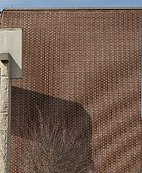Anti-aliasing filter
This article's lead section may be too short to adequately summarize the key points. (November 2020) |
This article needs additional citations for verification. (June 2023) |
An anti-aliasing filter (AAF) is a
Optical applications

In the case of optical image sampling, as by image sensors in digital cameras, the anti-aliasing filter is also known as an optical low-pass filter (OLPF), blur filter, or AA filter. The mathematics of sampling in two spatial dimensions is similar to the mathematics of time-domain sampling, but the filter implementation technologies are different.
The typical implementation in
Alternative implementations include the
Audio applications
Anti-aliasing filters are used at the input of an analog-to-digital converter. Similar filters are used as reconstruction filters at the output of a digital-to-analog converter. In the latter case, the filter prevents imaging, the reverse process of aliasing where in-band frequencies are mirrored out of band.
Oversampling
With
A signal may be intentionally sampled at a higher rate to reduce the requirements and distortion of the anti-alias filter. For example, compare
Bandpass signals
Often, an anti-aliasing filter is a low-pass filter; this is not a requirement, however. Generalizations of the Nyquist–Shannon sampling theorem allow sampling of other band-limited passband signals instead of baseband signals.
For signals that are bandwidth limited, but not centered at zero, a
Signal overload
It is very important to avoid input signal overload when using an anti-aliasing filter. If the signal is strong enough, it can cause clipping at the analog-to-digital converter, even after filtering. When distortion due to clipping occurs after the anti-aliasing filter, it can create components outside the passband of the anti-aliasing filter; these components can then alias, causing the reproduction of other non-harmonically related frequencies.[11]
Notes
- order.
References
- ISBN 0-240-51590-0.
- )
- ^
Brian W. Keelan (2004). Handbook of Image Quality: Characterization and Prediction. Marcel–Dekker. ISBN 0-8247-0770-2.
- ^
Sidney F. Ray (1999). Scientific photography and applied imaging. Focal Press. p. 61. ISBN 978-0-240-51323-2.
- ^
Michael Goesele (2004). New Acquisition Techniques for Real Objects and Light Sources in Computer Graphics. Books on Demand. p. 34. ISBN 978-3-8334-1489-3.
- ^ "Pentax K-3". Retrieved November 29, 2013.
- ^ Kester, Walt. "Oversampling Interpolating DACs" (PDF). Analog Devices. Retrieved January 17, 2015.
- ^ Nauman Uppal (August 30, 2004). "Upsampling vs. Oversampling for Digital Audio". Audioholics. Retrieved October 6, 2012.
- ^ Story, Mike (September 1997). "A Suggested Explanation For (Some Of) The Audible Differences Between High Sample Rate And Conventional Sample Rate Audio Material" (PDF). dCS Ltd. Archived (PDF) from the original on November 28, 2009.
- ^ Lavry, Dan (1997). "Sampling, Oversampling, Imaging and Aliasing - a basic tutorial" (PDF). Lavry Engineering. Archived (PDF) from the original on June 21, 2015.
- ^ Level and distortion in digital broadcasting (PDF), retrieved May 11, 2021


